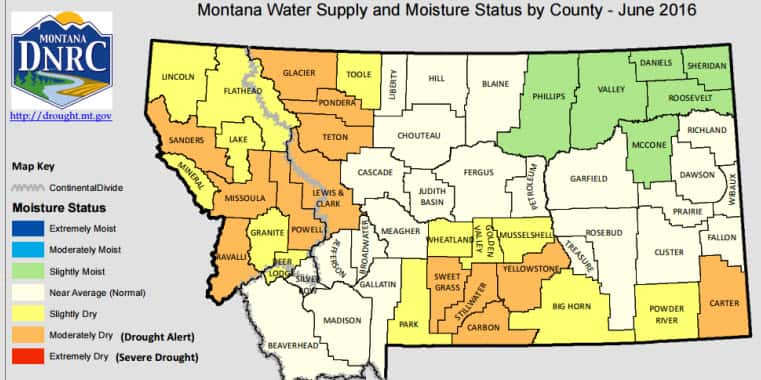HELENA, Mont. – More counties could be added to “Drought Alert” status at the state drought meeting in August and some areas could be declared in Severe Drought.
According to Ada Montague, the state drought coordinator, the Montana DNRC is getting reports from around the state indicating a cause for concern. Streams along the Rocky Mountain Front continue to show much below normal flows. Wheatland county recently got emergency haying and grazing assistance through the Conservation Reserve Program and cost share assistance to develop new livestock water sources through Emergency Conservation Program due to the lack of moisture, heat, wind and grasshoppers. Producers in Northern Powell county are hauling water to their cattle because the water holes were not filled in the spring and there’s been extensive wind evaporation.
Irrigators in the Bitterroot Valley met to figure out how to keep flows at Belle Crossing at 200 cfs, not the usual 400 cfs target flow of better years. The Blackfoot Challenge is preparing to initiate their drought response plan when flows at Bonner hit 700 cfs. Flows there are currently at 895 cfs.
Thirteen Montana counties currently are listed under “Drought Alert” status. Four counties had reached “Drought Alert” status in June: Glacier, Pondera, Teton, and northern Lewis and Clark. Nine additional counties were added in July: Carter, Carbon, Yellowstone, Stillwater, Sweet Grass, Powell, Ravalli, Missoula and Sanders.
http://docs.msl.mt.gov/geoinfo/CurrentDroughtMap/drtstatus.pdf
Cooney, who chairs the Governor’s Drought and Water Supply Advisory Committee, said the region has experienced two consecutive years of low snowpack, early runoff and minimal subsoil moisture. Despite mid-July rains, the previous monthly precipitation totals west of the divide and in the south-central and south-east portions of the state were in the 35-43{75e25ebeb47fb4337942be2c10689dca1c292c2a66240b62c5ca4214f5b25ecc} of normal.
According to the July 17th Crop Progress Report, about 59{75e25ebeb47fb4337942be2c10689dca1c292c2a66240b62c5ca4214f5b25ecc} of the state currently has adequate topsoil and subsoil moisture conditions, which is ~15{75e25ebeb47fb4337942be2c10689dca1c292c2a66240b62c5ca4214f5b25ecc} better than this time last year, and slightly better than the 5- year average. Local conditions vary widely, though. Soil moisture in the Yellowstone is only in the 5-10th percentile for much of Park, Gallatin, Sweet Grass, Rosebud, Custer, Carter, Powder River, Big Horn and Carbon counties.
Mike Honeycutt, Executive Director of the Department of Livestock reported that ranchers in several counties are experiencing reduced hay yields and pasture production needed for their cattle. Ranchers are faced with buying hay or reducing herd size heading into winter.
USDA NASS reported that they spoke with some wheat producers in Montana who are cutting wheat for hay. Due to low wheat prices and reduced hay yields, the producers believe the hay might be worth more than the wheat.
The Montana DNRC reported that the state's wildfire season has been mild so far, but noted it is still early. Most of the potential for significant wildfire outlook for the state is concentrated in the Southcentral part of Montana in addition to local burn bans in 5 counties.
http://firerestrictions.us/mt/
The “Drought Alert” designation does not carry any official status with respect to state or federal disaster assistance programs. Rather, “it is intended to give high visibility to the continuing impacts of drought in affected areas and to prompt communication among stakeholders,” Cooney wrote.
When a county is under a Drought Alert, county commissioners are encouraged to work with their local response efforts, especially FSA County Executive Directors (CEDs) who can document any impacts. This information can then be used to inform the drought response process at the federal level, including USDA drought relief programs.
However, in a spot of good news, the Montana DNRC reports that the warm/dry conditions of the last two years may be changing come this fall. The El Nino effect has been declared over by climatologists and now they are watching to see if the La Nina effect will take its place, which is what typically follows an El Nino cycle. Predictions indicate that it will likely be September before anyone will know if cooler, wetter conditions can be expected.
At the upcoming meeting of the Governor’s Drought and Water Supply Advisory Committee on August 18, committee members will assess the latest water supply, soil and climate conditions across the state. More counties could be added to “Drought Alert” status at that time, and some areas could be declared in Severe Drought.
For more information on current drought and water supply conditions, visit drought.mt.gov.
Drought Forums Scheduled for August and September
Source: Montana DNRC




